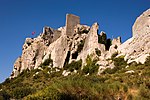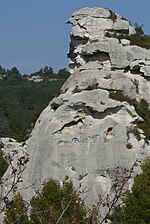Barbegal aqueduct and mills
Ancient Roman watermillsBuildings and structures in Bouches-du-RhôneFlour millsRoman aqueducts in FranceRoman sites in Provence ... and 3 more
Ruins in Provence-Alpes-Côte d'AzurTourist attractions in Bouches-du-RhôneWatermills in France

The Barbegal aqueduct and mills was a Roman watermill complex located on the territory of the commune of Fontvieille, Bouches-du-Rhône, near the town of Arles, in southern France. The complex has been referred to as "the greatest known concentration of mechanical power in the ancient world" and the 16 overshot wheels are considered to be the largest ancient mill complex.Another similar mill complex existed on the Janiculum in Rome, and there are suggestions that further such complexes existed at other major Roman sites, such as Amida (Mesopotamia).
Excerpt from the Wikipedia article Barbegal aqueduct and mills (License: CC BY-SA 3.0, Authors, Images).Barbegal aqueduct and mills
Elverssteinpfad,
Geographical coordinates (GPS) Address Nearby Places Show on map
Geographical coordinates (GPS)
| Latitude | Longitude |
|---|---|
| N 43.7025 ° | E 4.7213888888889 ° |
Address
Montagswanderer
Elverssteinpfad
38855 (Wernigerode)
Sachsen-Anhalt, Deutschland
Open on Google Maps











